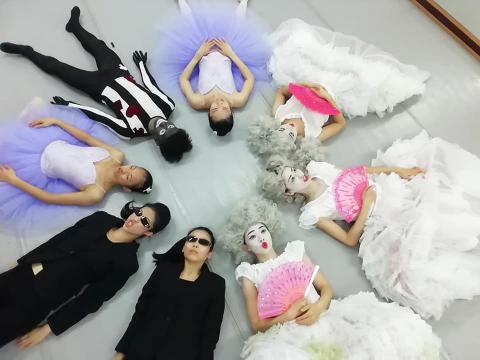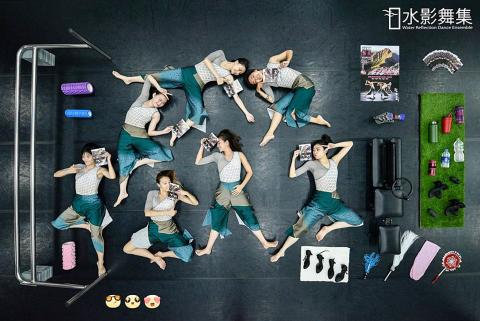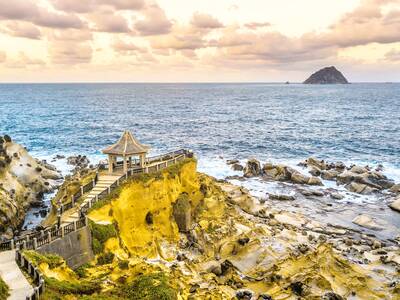The Taipei Capital Ballet (台北首都芭蕾舞團) is one of the nation’s oldest ballet troupes, having been established by the husband and wife team of Hsu Chin-feng (徐進豐) and Lee Shu-hui (李淑惠) in 1990, although it often falls under the radar despite their determination to bring local ballet not just to audiences in Taipei, but around the nation.
This weekend the company kicks off a four-city tour with its latest production, Variations on a Rococo Theme, with two shows at Taipei’s Metropolitan Hall, before traveling to Taoyuan, Nantou and Hsinchu.
The first piece on the double bill is set to Pyotr Ilyich Tchaikovsky’s Rococo Theme Variations for cello and orchestra, which was inspired by the work of his idol, Wolfgang Amadeus Mozart.

Photo courtesy of Taipei Capital Ballet
The dance follows the music, being divided into a theme, eight variations and a finale.
The second half of the performance is made up of three short works: Sangu Liupo, Dancing dolls and little blacks and Cool brother, works that are unified by their witty take on life and entertainment.
Over in New Taipei City, the Water Reflection Dance Ensemble (水影舞集), which has been around for 18 years, will perform its news work, 2019 Flower of Life (2019繁花).

Photo courtesy of Water Reflection Dance Ensemble
It further explores themes that choreographer Tan Hui-chen (譚惠貞) used for a 2016 production by the same name celebrating the work of several female Taiwanese poets, set to the music of Luo Si-rong (羅思容).
Through her choreography and her seven female dancers, Tan seeks to demonstrate the enormous and strong life energy of women and the richness of contemporary social culture in Taiwan.
■ The Taipei Capital Ballet tomorrow at 7:30pm and Sunday at 2:30pm
■ Metropolitan Hall (城市舞台), 25 Bade Rd, Sec 3, Taipei (台北市八德路三段25號).
■ Tickets are NT$400 to NT$1,200. Available at NTCH box offices, Eslite ticket desks, online at www.artsticket.com.tw and convenience store ticket kiosks
■ Additional performances: on Oct. 26 at 7:30pm the Taoyuan Department of Cultural Affairs (桃園市政府文化局), 21, Xianfu Rd, Taoyuan City (桃園市縣府路21號), tickets NT$400; on Nov. 2 at 7:30pm at the Concert Hall of Cultural Affairs Bureau of Nantou County (南投縣文化局演藝廳), 135 Chienkuo Rd, Nantou City (南投市建國路135號), tickets NT$200 and on Nov. 9 at 7:30pm at the Hsinchu Municipal Performance Hall (新竹市文化局演藝廳), 16, Dongda Rd Sec 2, Hsinchu City (新竹市東大路二段17號), tickets NT$300 and NT$500
■ The Water Reflection Dance Ensemble will be at the New Taipei City Arts Center (新北市藝文中心演藝廳), 62 Jhuangjing Rd, Banciao District, New Taipei City (新北市板橋區莊敬路62號), tomorrow at 7:30pm and Sunday at 2:30pm
■ Tickets are NT$400 to NT$800, available as above NTCH box offices, Eslite ticket desks, online at www.artsticket.com.tw and convenience store ticket kiosks

The low voter turnout for the referendum on Aug. 23 shows that many Taiwanese are apathetic about nuclear energy, but there are long-term energy stakes involved that the public needs to grasp Taiwan faces an energy trilemma: soaring AI-driven demand, pressure to cut carbon and reliance on fragile fuel imports. But the nuclear referendum on Aug. 23 showed how little this registered with voters, many of whom neither see the long game nor grasp the stakes. Volunteer referendum worker Vivian Chen (陳薇安) put it bluntly: “I’ve seen many people asking what they’re voting for when they arrive to vote. They cast their vote without even doing any research.” Imagine Taiwanese voters invited to a poker table. The bet looked simple — yes or no — yet most never showed. More than two-thirds of those

In the run-up to the referendum on re-opening Pingtung County’s Ma-anshan Nuclear Power Plant last month, the media inundated us with explainers. A favorite factoid of the international media, endlessly recycled, was that Taiwan has no energy reserves for a blockade, thus necessitating re-opening the nuclear plants. As presented by the Chinese-language CommonWealth Magazine, it runs: “According to the US Department of Commerce International Trade Administration, 97.73 percent of Taiwan’s energy is imported, and estimates are that Taiwan has only 11 days of reserves available in the event of a blockade.” This factoid is not an outright lie — that

Former Chinese Nationalist Party (KMT) chairwoman Hung Hsiu-chu’s (洪秀柱) attendance at the Chinese Communist Party’s (CPP) “Chinese People’s War of Resistance Against Japanese Aggression and the World Anti-Fascist War” parade in Beijing is infuriating, embarrassing and insulting to nearly everyone in Taiwan, and Taiwan’s friends and allies. She is also ripping off bandages and pouring salt into old wounds. In the process she managed to tie both the KMT and the Democratic Progressive Party (DPP) into uncomfortable knots. The KMT continues to honor their heroic fighters, who defended China against the invading Japanese Empire, which inflicted unimaginable horrors on the

Sitting on a bus bound for Heping Island (和平島), at the start of my first visit to Keelung in years, I was hell-bent on visiting a place of considerable historical interest, even though I knew that it wasn’t officially open to the public. In 2011, archaeologists working in the densely populated southern half of the island unearthed the foundations of the Convento de Todos los Santos (Convent of All Saints, 諸聖教堂), a Catholic house of worship established during Spain’s 1624-1642 occupation of northern Taiwan. I’d heard about its rediscovery a while ago, but it wasn’t until I read a scholarly